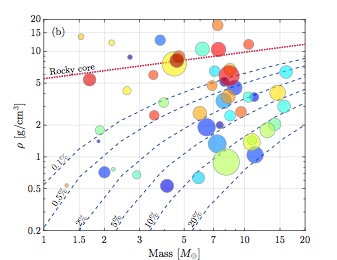Research


Research


Planet Formation




1)Extrasolar Planets:
With the number of known exoplanets climbing into the thousands, exoplanet research is at a truly exciting time. And although current sensitivity limits are such that true Solar system analogs remain challenging to detect, numerous exoplanets have been discovered that are very different from our own Solar system. The majority of systems known to date harbor a new class of planets, bodies that are typically several times more massive than the Earth but that orbit their host stars well inside the orbit of Mercury. Our work focuses on where and how this new class of planets formed.
2)Orbital Dynamics
In addition to their composition, the orbital architecture of planetary systems also contains some important clues for understanding planet formation. When examining the resonance behavior of many of the Kepler planets we realized that most of them will, due to their small masses, undergo overstable librations, leading to escape from resonance. The resonance evolution in the presence of both disk migration and eccentricity damping for such planets is therefore fundamentally different from that of more massive gas giants (Goldreich & Schlichting 2014). Overstable libations are likely the reason for the observed relative depletion of the 2:1 resonance compared to other first order resonance and may play a vital role in explaining the paucity of Kepler planets in resonance. Overstable librations likely also played a key role in the resonance evolution of satellites systems of Saturn and Jupiter.
3)The Kuiper Belt & Stellar Occultations
The Kuiper Belt is located at the outskirts of our planetary system just beyond the orbit of Neptune. It is believed to be the source region of the short period comets. However cometary sized bodies are typically too small to be detected in reflected light when still residing in the Kuiper Belt. Such objects can however be detected indirectly by stellar occultations. As a small object crosses the line of sight to a background star it will partially obscure the stellar light, which can be detected in the star's light curve. In 2009 we analyzed 30,000 star hours of data obtained with the Hubble Space Telescope and reported the first occultation of a background star by a km-sized Kuiper Belt object (Schlichting et al. 2009, Nature). My group is working on the analysis of the remaining HST data hoping to find additional occultation events (Schlichting et al. 2012). We are also collaborating with Gregg Hallinan’s group at Caltech, which built a dedicated instrument called CHIMERA for the 200-inch Hale Telescope at Palomar, to carry out an occultation survey from the ground, that is 10-100 times more powerful than our current HST survey.

4)Terrestrial Planet Formation
Studying the formation of terrestrial planets is particular fascinating, not only because we live on one, but also because
geochemical and cosmochemical constraints provide a wealth of information about their origin that complements dynamical planet formation models. My group is working on various aspects of terrestrial planet formation. For example, we combined dynamical models of planet formation with geochemical constrains to study late accretion of planetesimals (Schlichting et al. 2012); we also examined atmospheric loss and volatile delivery to the terrestrial planets by planetesimal impacts and giant collisions (Schlichting et al. 2015) trying to understand the early Earth’s atmosphere and the origin of its water.


All my work is driven by the desire to understand the formation of Planets both at home in our own Solar system and abroad in Exoplanet systems. My group & I study planet formation from various different angles using planet formation theory, orbital dynamics & solar system & exoplanet observations. A sample of some of our current research is outlined below:
Figure 1: Orbital period and physical radii of known Exoplanets. Exoplanets discovered by the Kepler mission are represented as blue points, the red line corresponds to the radius of Neptune. Mercury, Venus and Earth are shown for comparison in the lower right corner.
Examples of recent research carried out with my group and collaborators include work examining the amount of material needed to form the close-in Exoplanet systems shown in Figure 1 (Schlichting 2014), calculating self-consistently how much gas these planets accreted as envelopes and retained since their formation (Ginzburg, Schlichting & Sari 2016), and suggesting that the large diversity displayed in exoplanet mean densities (see Figure 2) is due to giant impacts that can strip a significant fraction of the gaseous atmospheres (Inamdar & Schlichting 2016).

Figure 2: Exoplanet masses and mean densities. The red line gives the expected mean density for planets composed entirely of rock, the dashed blue lines correspond to mean densities for planets with rocky cores that are surrounded by gaseous envelopes containing various % of their total mass. Many Exoplanets have significant gaseous envelopes containing several % of their mass.
Figure 3: Resonance evolution for a typical Kepler planet orbiting a Sun-like star in the presence of both migration and eccentricity damping caused by the gas disk. After resonance capture, the libration amplitude grows and the separatrix is crossed leading to escape from resonance.


Figure 4: Photon counts as a function of time of the occultation event (red points) reported by Schlichting et al. (Nature, 2009). The best-fit template (dashed blue line) corresponds to a Kuiper Belt object that is 520m in radius and located at a distance of 45AU. The original press release from the Space Telescope Science Institute can be found here.
Figure 5: Illustration of a planetesimal impact. Small impactors can only eject atmosphere locally. The maximum atmospheric mass that they can eject in a single impact is given by all the mass above the tangent plane. However, since smaller impactors are more numerous than larger ones required for giant impacts, smaller impactors may actually dominate the atmospheric mass loss during terrestrial planet formation.
